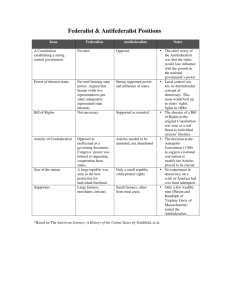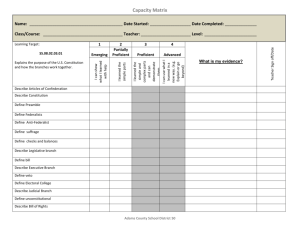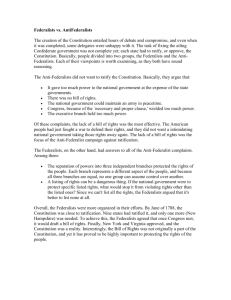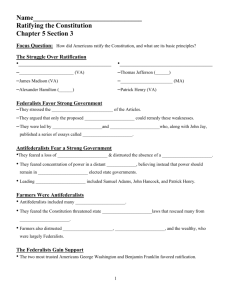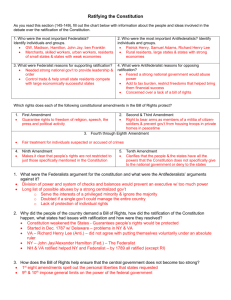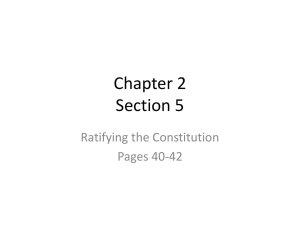RatificationDebate_DF
advertisement
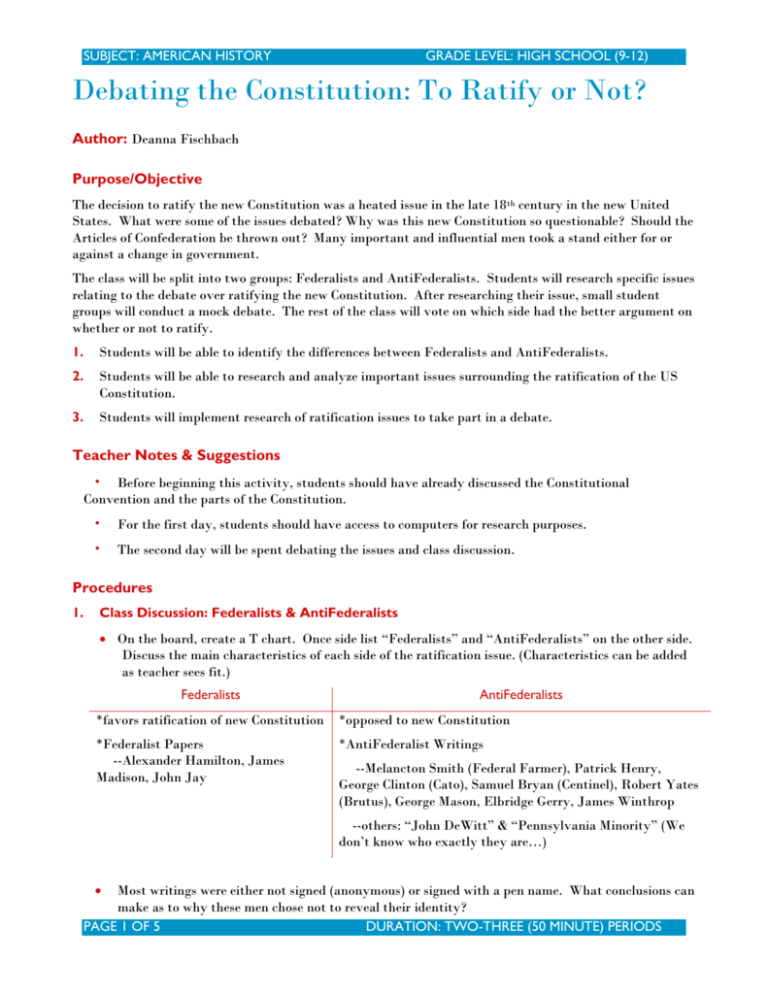
SUBJECT: AMERICAN HISTORY GRADE LEVEL: HIGH SCHOOL (9-12) Debating the Constitution: To Ratify or Not? Author: Deanna Fischbach Purpose/Objective The decision to ratify the new Constitution was a heated issue in the late 18 th century in the new United States. What were some of the issues debated? Why was this new Constitution so questionable? Should the Articles of Confederation be thrown out? Many important and influential men took a stand either for or against a change in government. The class will be split into two groups: Federalists and AntiFederalists. Students will research specific issues relating to the debate over ratifying the new Constitution. After researching their issue, small student groups will conduct a mock debate. The rest of the class will vote on which side had the better argument on whether or not to ratify. 1. Students will be able to identify the differences between Federalists and AntiFederalists. 2. Students will be able to research and analyze important issues surrounding the ratification of the US Constitution. 3. Students will implement research of ratification issues to take part in a debate. Teacher Notes & Suggestions • Before beginning this activity, students should have already discussed the Constitutional Convention and the parts of the Constitution. • For the first day, students should have access to computers for research purposes. • The second day will be spent debating the issues and class discussion. Procedures 1. Class Discussion: Federalists & AntiFederalists On the board, create a T chart. Once side list “Federalists” and “AntiFederalists” on the other side. Discuss the main characteristics of each side of the ratification issue. (Characteristics can be added as teacher sees fit.) Federalists AntiFederalists *favors ratification of new Constitution *opposed to new Constitution *Federalist Papers --Alexander Hamilton, James Madison, John Jay *AntiFederalist Writings --Melancton Smith (Federal Farmer), Patrick Henry, George Clinton (Cato), Samuel Bryan (Centinel), Robert Yates (Brutus), George Mason, Elbridge Gerry, James Winthrop --others: “John DeWitt” & “Pennsylvania Minority” (We don’t know who exactly they are…) Most writings were either not signed (anonymous) or signed with a pen name. What conclusions can make as to why these men chose not to reveal their identity? PAGE 1 OF 5 DURATION: TWO-THREE (50 MINUTE) PERIODS SUBJECT: AMERICAN HISTORY GRADE LEVEL: 9-12 2. Group Work: Research Split class into two groups: Federalists & AntiFederalists. o Explain to the class that each side will be given a set of issues. Each large group will divide into smaller groups in order to specialize in a particular issue. o After research, class debates will be conducted on each issue. Issues—to be researched. Keep in mind which side of the issue you should focus on. (Note: depending on class size, the number of issues can be decreased) o Bill of Rights o Defense (Armies) o Power of National Government o Legislative Branch o Executive Branch o Judicial Review Websites with Federalist & AntiFederalist writings (to help prepare for debates) o Federalist Whitten, Chris. “Federalist Papers.” Founding Fathers.info. N.p., n.d. Web. 15 May 2011. http://www.foundingfathers.info/federalistpapers.fedindex.htm “The Federalist Papers.” Library of Congress: Thomas. Library of Congress, n.d. Web. 15 May 2011. http://thomas.loc.gov/home/histdox/fedpapers.html o AntiFederalist Rice, William. “AntiFederalist Papers.” William G. Rice, Associate Professor of Law. University of Tulsa, 25 Aug 2008. Web. 15 May 2011. http://www.utulsa.edu/law/classes/rice/Constitututional/AntiFederalist/antifed.htm . Mott, Jonathon. “The Antifederalist Papers.” ThisNation.com. N.p., n.d. Web. 15 May 2011. http://thisnation.com/library/antifederalist/. o Other Websites Roland, Jon. “Chronology.” Constitution Society. N.p., n.d. Web. 15 May 2011. http://www.constitution.org/afp/afpchron.htm. Lloyd, Gordon. “Introduction to the Antifederalists.” Teaching American History. Ashbrook Center, n.d. Web. 15 May 2011. http://teachingamericanhistory.org/fedantifed/antifederalist.html. “Federalists Versus Anti-federalists.” Constitution of the United States. Net Industries, n.d. Web. 18 May 2011. http://law.jrank.org/pages/5603/ConstitutionUnited-States-FEDERALISTS-VERSUS-ANTI-FEDERALISTS.html. “The Constitution of the United States of America.” Almanac of Policy Issues. US State Department, June 2004. Web. 18 May 2011. http://www.policyalmanac.org/government/archive/constitution.shtml. PAGE 2 OF 5 DURATION: TWO-THREE (50 MINUTE) PERIODS SUBJECT: AMERICAN HISTORY GRADE LEVEL: HIGH SCHOOL (9-12) 3. Class Debate Federalist and AntiFederalist groups will debate each issue concerning the ratification of the Constitution. o Each issue will be given 5-6 minutes of debate time (2-3 minutes per side). The small groups assigned to the particular issue will present to each other and the rest of their class their particular arguments. The class members not involved in that particular issue will listen carefully and be given the chance to ask questions for clarification. o After each issue is debated, non-debating class members will complete the Decision Sheet and hand it to the instructor. 4. Class Discussion Instructor hands back the Decision Sheets to each student. Using their sheets, have students determine whether or not they would vote for ratification. Vote as a class. Lead a class discussion using the following questions: o Was the change in government necessary? o Why did most of the Federalists and AntiFederalists remain anonymous? o Would it have made a difference if there were publicized debates? o Would today’s technology have had a major impact? Why or why not? Assessments Class debate (rubric included) Can use class discussion questions as essay questions Content Standards: South Dakota State Standards (http://doe.sd.gov/contentstandards/index.asp) 8.US.1.1. Students are able to relate events and outcomes of the American Revolution to sources of conflict, roles of key individuals and battles, and political documents. 9-12.US.1.2. Students are able to relate previously learned information of these time periods to the context of succeeding time periods. 9-12.US.2.2. Students are able to describe the causes and effects of cultural, economic, religious, political, and social reform movements on the development of the U.S. National US History (http://www.nchs.ucla.edu/Standards/us-history-content-standards) Era 3: Revolution & The New Nation (1754-1820s). Standard 2: The impact of the American Revolution on politics, economy, and society. Era 3: Revolution & The New Nation (1754-1820s). Standard 3: The institutions and practices of government created during the Revolution and how they were revised between 1787 and 1815 to create the foundation of the American political system based on the US Constitution and the Bill of Rights. PAGE 3 OF 5 DURATION: TWO-THREE (50 MINUTE) PERIODS SUBJECT: AMERICAN HISTORY GRADE LEVEL: 9-12 Name _____________________________________________________ Period ________ Debating the Constitution: To Ratify or Not? Decision Sheet Issue debated Federalist Arguments AntiFederalist Arguments Would you ratify the Constitution based on this issue? Yes or No & explain your answer. Name _____________________________________________________ Period ________ Debating the Constitution: To Ratify or Not? Decision Sheet Issue debated Federalist Arguments PAGE 4 OF 5 AntiFederalist Arguments Would you ratify the Constitution based on this issue? Yes or No & explain your answer. DURATION: TWO-THREE (50 MINUTE) PERIODS SUBJECT: AMERICAN HISTORY GRADE LEVEL: HIGH SCHOOL (9-12) Name _________________________________________________ Period _____________ Debating the Constitution: To Ratify or Not? Debate Rubric Group Members: Issue: Category 1 point 2 points 3 points 4 points Information Information had several inaccuracies OR was usually not clear Most information presented in teh debate was clear and accurate, but was not usually thorough Most information in the debate was clear, accurate, and thorough All information presented in the debate was clear, accurate, and thorough Use of Facts Every point was not supported Every major point was supported with facts and/or examples, but the relevance of some was questionable Every major point was adequately supported with relevant facts and/or examples Every major point was well supported with several relevant facts and/or examples Organization Arguments were not clearly tied to the issue All arguments were clearly tied to the issue but the organization was sometimes not clear or logical Most arguments were clearly tied to the issue and organized in a tight, logical fashion All argumetns were clearly tied to the issue and organized in a tight, logical fashion Understanding of Topic The team did not show an adequate understanding of the topic The team seemed to understand the main points of the topic and presented those with ease The team clearly understood the topic in-depth and presented their information with ease The team clearly understood the topic in-depth and presented their information convincingly Total Score PAGE 5 OF 5 DURATION: TWO-THREE (50 MINUTE) PERIODS /16


